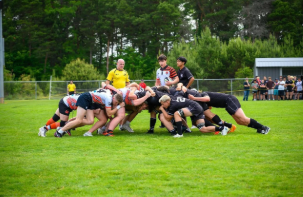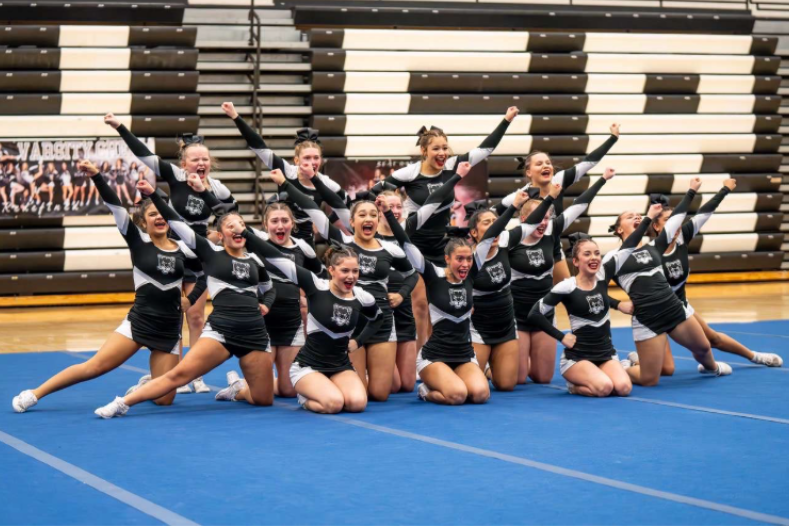Water polo is often described as a mix of swimming, basketball, and wrestling – all in the water. It’s a demanding sport that requires incredible endurance, strength, and tactical thinking. The district tournament is being held at West Ottawa this weekend on Friday and Saturday. Here are some basics to help you enjoy the games.
A water polo team consists of seven players: six field players and one goalie. The offensive positions are arranged in an umbrella formation, similar to basketball. This helps the team move the ball around quickly and hope to possibly score a goal.
These positions are called the Wings, located right next to the goal; the Drivers, positioned one step above the wings; the Point, at the top of the formation; and the Hole, in front and center of the goal. Each position has its unique importance: the Hole has the easiest shot but the hardest time getting open for a pass; the Wings move the ball around and try to surprise the goalie; the Drivers move around, create chaos, and seek open passing lanes; and the Point moves the ball and is there to quickly transition back on defense. Any position can shoot and score, including the goalie. When you watch WO play, keep an eye on #6. She is a force to be reckoned with, she is able to hold on to the ball while being double teamed and can drive in right up to the goal and score almost every time she’s that close.
On defense, the set up is basically the same. It has a similar formation but other teams like to switch it up. “I like to play the center defense the most. Defense is personal, which is what I like best. I like the strategy of anticipating passes and blocking shots. On offense though I like to be a driver so I have a good outside shot but also the ability to move in for a goal,” Sr. Izzy Steele said.
Next thing you’ve got to learn about is the markings and what they mean. The pool has meter markings on the lane lines along the outside of the field, similar to soccer. The 2-meter line indicates that a player can only be in that area if they have the ball; otherwise, it’s a turnover. The 5-meter line marks the spot for penalty shots. The 6-meter line helps players know when they draw a foul, requiring them to either pass or shoot. During a foul, players can only shoot from outside the 6-meter mark; if inside, they must pass to a teammate.
Here’s where it gets interesting. Water polo has a unique set of rules designed to keep the game flowing and (relatively) safe. Fouls are common and come in two types: ordinary and major. Ordinary foul results in a free throw for the opposing team. One example of an ordinary foul is an attempt to move the ball up the pool and the defense prohibiting the movement. Major fouls, known as kick-outs, lead to an exclusion where a player gets sidelined for 20 seconds. A player gets a major foul by not giving enough space on a foul, another is when deafening the Hole position, the defender is holding the player with two hands down. Three exclusion fouls, and you’re out of the game! Penalty shots are awarded when a major foul prevents a likely goal inside the five-meter line.
The game is divided into four quarters, typically lasting 7 minutes each. Players can only advance the ball by swimming and passing, and they can’t walk on the pool floor. They can only hold the ball with one hand, except for the goalie, who can use two hands inside their five-meter area. The goal is to outscore the opposing team by throwing the ball into their net.
“The best shot I ever made was this January during our club Florida tournament. I was coming off of a slump my whole summer season. We were playing Orlando, which is their state champion from the previous season. We were tied at half with a few seconds left on the clock and I was out at wing and passed the ball from point. I whipped the ball at the goal and it was a corner post in. I didn’t think I made it but it just went past the goal line and everyone cheered. It was the end of my slump and I was so proud of it,” Sr. Ellie Mayo said.
You’ll hear the whistle blow a lot, followed by hand signals by the official. In water polo, the referee’s whistle is crucial for signaling fouls, stoppages, and the end of playing time. A short, sharp whistle typically indicates a foul, while a longer whistle might signal the end of a period or a time-out. Hand signals complement the whistle, providing visual confirmation of the referee’s call. These signals are standardized and easily understood by players and coaches.
An example is, a raised arm might indicate a goal, while specific hand gestures might signify different types of fouls, such as holding, sinking, or exclusion penalties. The combination of whistle and hand signals ensures clear communication on the water, even amidst the splashing and fast-paced action of the game. This system is essential for maintaining fairness and order in the sport.
This sport is fun and exciting to watch and more people should come and watch the WO girls play. The team has come very far from the start of the program especially in the last 4 years. The girls are ranked 3rd at Districts this year. The team has grown almost double in size and that has definitely helped their performance this year compared to recent seasons.
Districts this year are hosted at West Ottawa, the Panthers play at 6:15 on Friday the 16th, so come out and support the team.







